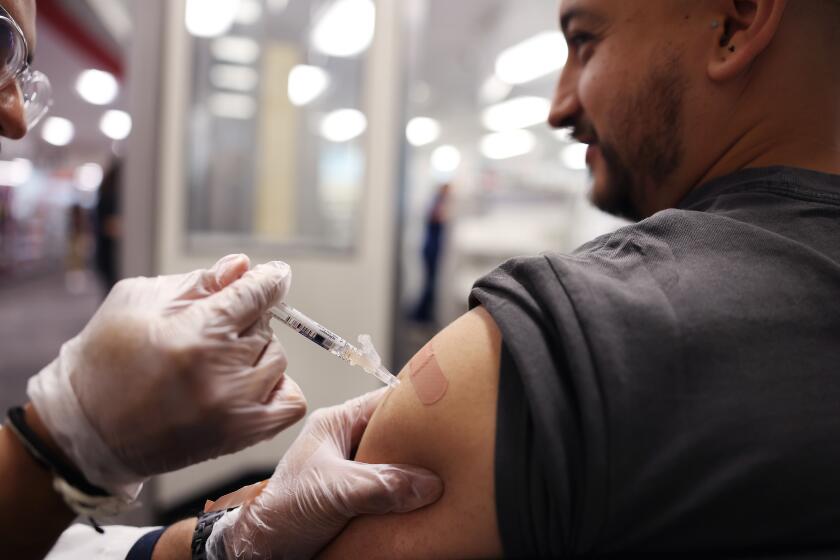Tweaked helmet would better protect our troops
It is the “signature wound” of the Iraq and Afghanistan wars: traumatic brain injury from the blast of the enemy’s improvised explosive devices. Now two researchers say that minor changes in the military’s combat helmet could reduce the incidence and severity of these injuries.
Using complex computer modeling to determine the impact of such blasts on helmets, physicist Willy Moss and mechanical engineer Michael King of the Lawrence Livermore National Laboratory in Northern California concluded that soldiers and Marines would be better protected by wearing a slightly larger helmet with 1/8 inch more foam padding.
“I’m almost embarrassed,” King said, that the finding was so simple.
The two researchers had been selected by the Army and its Joint IED Defeat Organization, which is looking for better ways to protect military personnel against improved explosive devices, to perform the yearlong, $540,000 study based on previous work on blast-induced traumatic brain injury.
The assignment was to test which kind of helmet liner provided the most protection: two pads used by the Army, two used by the National Football League, and one used in other sports equipment. The pads had different configurations and hardness of foam, and different spacing and design of air pockets.
King and Moss found that the Army pads worked the best — but could work even better with just a slight change in thickness. “What we found amazing was that our results suggested a very low-cost strategy,” Moss said.
The NFL pads, the two researchers found, didn’t work as well because they were more rigid than the Army pads and thus allowed forces to be “transferred” to the head. The Army pad, 3/4 of an inch thick, absorbs a larger amount of the force.
The results of their tests have been forwarded to the Army and the Marine Corps for review and possible further testing.
At a Pentagon news conference Tuesday, officials said the findings would be included in the continuing research in several Army commands to design the safest possible helmet. A meeting is set for next month for military researchers involved in helmet design.
“This is a ‘physics’ answer — now we’re trying to tie it back to the head,” said Brig. Gen. Peter Fuller, program executive officer with an Army command dedicated to developing improved equipment.
Traumatic brain jury is defined as a concussion that can occur even without the skin being broken. The Department of Defense says that more than 130,000 military personnel have suffered traumatic brain jury in Iraq and Afghanistan.
Symptoms include headaches, loss of balance, difficulty driving, visual distortions, memory loss and trouble sleeping.
Earlier testing had suggested that the Army helmet, which is designed to cushion against a direct impact, was less suited to a blast-wave from an explosion, King and Moss said.
They found that if soldiers were to wear a helmet one size larger, with additional padding, their chances of avoiding traumatic brain jury would be improved by 24%. Helmets come in small, medium, large and extra-large.
However, the increased weight could be a stumbling block. Half of all soldiers and Marines wear a large-size helmet. The next size up is 9 ounces heavier, at 3 pounds 14 ounces.
Col. William Cole, a specialist in individual protection equipment, said soldiers at Ft. Benning, Ga., objected to adding even a single ounce to their helmets, let alone 9 ounces. A heavier helmet, he added, could also restrict maneuverability — although using a lighter material for the helmet could offset the added weight from the larger size.
Cole’s experience at Ft. Benning differed from that of Moss when he went to Tampa, Fla., to meet with U.S. Special Forces soldiers. He said he was buoyed by their positive response to wearing slightly larger helmets.
“I used that as my sanity check,” he said. “I trust those guys.”
This is not the first time researchers have suggested that a change in the military helmet could better protect troops. Last year, a team from MIT suggested that a face shield could provide protection because the face is the “pathway” through which pressure from a blast travels to the brain.
Best known for its weapons design work, the Lawrence Livermore National Laboratory does research projects for the departments of Defense, Energy and Homeland Security. Among its recent projects are environmental cleanup and cancer research.
The helmet project is just one of several attempts by the military to find solutions to the traumatic brain injury problem:
• The Landstuhl Regional Medical Center, the U.S. military hospital in Germany, this year opened a Traumatic Brain Injury Rehabilitation Center with specialists in neurology, optometry, audiology, physical therapy, speech language pathology, occupational therapy, psychology and nursing. All patients brought to the medical center from Iraq and Afghanistan are tested for traumatic brain injury, which Air Force Major Megumi Vogt, medical program chief there, likens to “when something knocks the wheels out of alignment on your vehicle.”
• The Marine Corps last year established a Concussion Care Center at Camp Leatherneck, the Marines’ major base in Afghanistan, staffed by Navy doctors, a psychologist and a chaplain.
Marines and soldiers with symptoms of traumatic brain injury are evaluated and treated there. Only when they have not experienced a symptom for seven days are they allowed to return to their unit. In some cases, “even reading a book is too much strain for the brain in the first few days” after an injury, said Navy Cmdr. Earl Frantz, a doctor specializing in sports medicine.
• Studies are planned by the Department of Defense and Department of Veterans Affairs to evaluate various evaluation and rehabilitation strategies for traumatic brain injury. One study plans to look at 1,200 veterans of Iraq and Afghanistan over 15 years.



